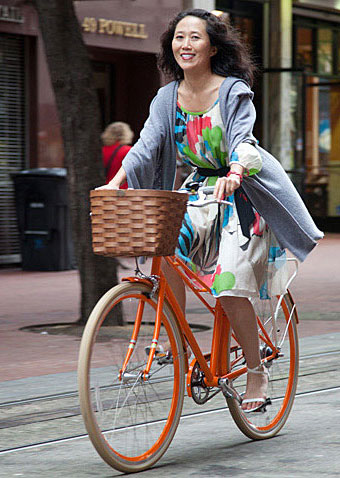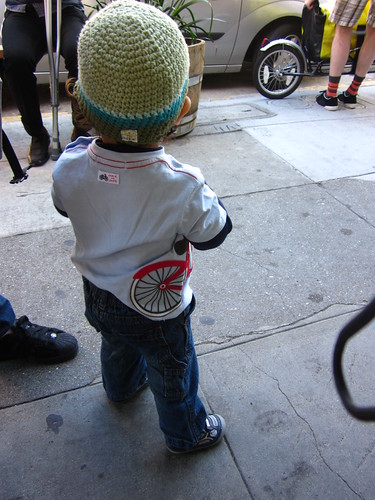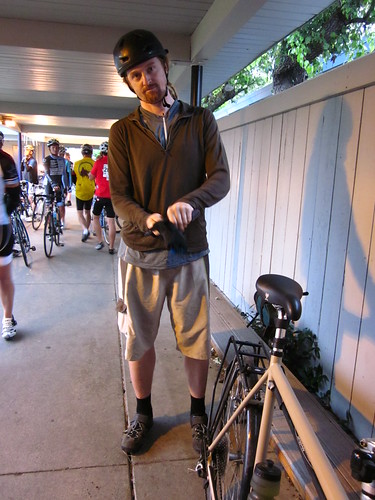I started writing this terribly long post awhile ago. I have decided to leave it as is, unedited and rambling. Read it and continue the conversation in the comments, should you chose to accept the challenge. I am sure that you all have more to say that makes sense than I do!
I think it is time that we all started talking about "bicycle culture". It is a term that gets thrown around a lot, but I am not sure that anyone could actually define what it is if asked. Can you? I can't. There is a lot out there about adding to bicycle culture and creating bicycle culture and defending bicycle culture. There are whole blogs about it : ) but what do we mean when we say these things?
So today I thought about it. Having lived in San Francisco for the vast majority of my life I have been able to see what bicycling in the City has been like for the last few decades. When I was a kid in the 70's and early 80's it was just what everyone did in my little beach community. We all got around by bike or train or Mustang GT. We didn't think about it, we just did it. The bicycles were just part of the landscape, and unless they were 10 speed road bikes (which were sooooo cool) they were just bikes. We parked them outside of the corner store to get a soda, we rode them to the other end of the beach so our parents wouldn't see us smoking, we took them to the park to play ball. We only thought about them when they were stolen. Our parents used them as a means of not having to pick us up from anything.
By the time the mid-80's came around, something started to change. It became strange to ride a bicycle for any other purpose than competitive racing or to storm the dirt trails of any planted area you could find. This was the beginning of bicyclists as a fringe element. Whereas just 5 years before when you got on your old Schwinn to go to the library, now there was neon, lycra clothing and knobby tires and flat handle bars and a horror of anything practical like fenders or baskets or kickstands. We started wearing helmets that looked like toddler training potties. Of course, if all the riding we did was jumping over logs, then this wasn't so strange, but there was still that trip to the Park & Rec that needed to happen to take a cooking class. The only way to do it by bicycle had become a lycra, chamois, helmet experience and if we tried to do otherwise we were ridiculed and driven off the road.
This was the beginning of "bicycle culture". When we allowed ourselves to be easily pegged, and thus, marginalized by donning more gear than the guys on the Tour de France did just so we could ride along the beach in the summer. Those who rode a bicycle became a deliberately visible group, defined by the activity of riding and the accouterments that we put with it. We came to a collective agreement that unless you walked away from your bicycle dirty and exhausted that you were not a legitimate bicycle rider. We read magazines with articles about maximizing pedal stroke and how to shave grams and most of all, we became afraid of our bicycles.
By the early 90's we were all convinced that our bicycles would kill us if given half a chance. If we rode on a city street, we would be immediately struck down by a car. If we rode on the sidewalk we would get hit by a car pulling out of a driveway. It was indisputable. If we rode on a trail we would get thrown by every pothole or stick in the forest. If we did not wear a helmet, Satan would find us and it would be our own fault that we were dead. In response we became one of three types of riders- non-riders who looked at their bicycles in the garage and thought "I would ride it to the beach but...", weekend sport riders who drove their bikes to points of embarkation away from the crazy streets of death, or urban street warriors who would "live free or die". That was the next step of "bicycle culture". Those who didn't disappear became almost superhuman in the eyes of the non-cycling world (whether that was super-humanly stupid or super-humanly strong was up to the changing interpretation of society at the time).
The 90's were also the beginning of what we see in San Francisco, today. The 90's were the time of the bicycle messenger and the beginning of
Critical Mass. While both were, and continue to be, somewhat controversial, they were nonetheless, the only non-sports related bicyclists any of us saw in San Francisco for a whole lotta years. They were almost all male, almost all young, almost all completely broke, and many of them were drawn to the drama of the daily fight for survival in streets that no longer welcomed any thing with less than 4 wheels and 150 horsepower. They looked nothing like the Bicycle Girls of Copenhagen. Hell, they didn't look like the Office Girls of the Financial District (remember the big hair and the skirt suits?). They were brash, confrontational, brave and fast and the people of San Francisco could only ever see them through the haze of bicycle fear that had engulfed the nation.
Until recently, this was the status quo of San Francisco. That has changed quite a bit. The people on the bikes look like the people walking on the sidewalk. The bicycles are no longer of the mountain type. More than that, there are lots of them. Everywhere. And they are all going to work or shopping or lunch or school...
Still, what is our current "culture"? I am not sure there is an answer to this question. There are so many different kinds of people riding and so many different kinds of groups that they could fit into that I do not think that there is a way to define it simply. Nor do I think it would be good to be able to do so. Back when just about every cyclist on the street was a kamikaze messenger we could define the culture very easily, and subsequently, very few people wanted to join in. Without firm definitions anyone can find a place.


















































